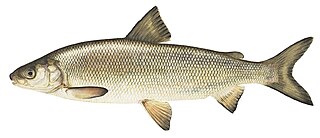
Coregonus is a diverse genus of fish in the salmon family (Salmonidae). The Coregonus species are known as whitefishes. The genus contains at least 68 described extant taxa, but the true number of species is a matter of debate. The type species of the genus is Coregonus lavaretus.

Coregonus lavaretus is a species of freshwater whitefish, in the family Salmonidae. It is the type species of its genus Coregonus.

Stenodus leucichthys is a species of freshwater whitefish in the family Salmonidae. In the strict sense its natural distribution is restricted to the Caspian Sea basin, and it is known as beloribitsa. The beloribitsa is now considered extinct in the wild, but survives in cultured stocks. The nelma, a more widespread species of Eurasian and North America, is sometimes considered its subspecies.

The gwyniad is a freshwater whitefish native to Bala Lake in northern Wales.
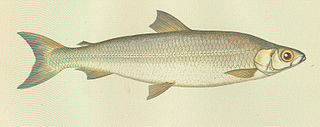
The pollan or Irish pollan is a freshwater whitefish known only from five Irish lakes, Lough Neagh, Lower Lough Erne, Lough Ree, Lough Derg, and Lough Allen. The Irish pollan faces competition from introduced species such as pike, roach, and zebra mussel and the populations rely on restocking for survival.
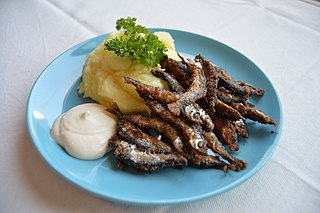
Coregonus albula, known as the vendace or as the European cisco, is a species of freshwater whitefish in the family Salmonidae. It is found in lakes in northern Europe, especially Finland, Latvia, Lithuania, Sweden, Russia and Estonia, and in some lakes of Norway, the United Kingdom, northern Germany, and Poland. It is also found in diluted brackish water in the Gulfs of Finland and Bothnia, both of which are in the Baltic Sea.

Arctic cisco is an anadromous species of freshwater whitefish that inhabits the Arctic parts of Siberia, Alaska and Canada. It has a close freshwater relative in several lakes of Ireland, known as the pollan, alternatively regarded as conspecific with it, or as a distinct species.

The broad whitefish is a freshwater whitefish species. Dark silvery in colour, and like a herring in its shape, its distinctive features include a convex head, short gill rakers, and a mild overbite. It is found in the Arctic-draining streams, lakes, and rivers of far eastern Russia and North America. Its prey includes larval insects, snails, and shellfish. It is eaten by humans and brown bears.
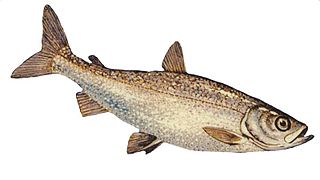
Coregonus hoyi, also known as the bloater, is a species or form of freshwater whitefish in the family Salmonidae. It is a silvery-coloured herring-like fish, 25.5 centimetres (10.0 in) long. It is found in most of the Great Lakes and in Lake Nipigon, and inhabits underwater slopes. This fish is not to be confused with the extinct deepwater cisco, a large fish that shared a common name with the bloater.
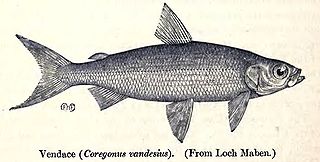
Coregonus vandesius, the vendace, is a freshwater whitefish found in the United Kingdom. Population surveys since the 1960s have revealed a steady decline and the fish is no longer present in some of its previous haunts but is still present in Bassenthwaite Lake and Derwent Water. The main threats it faces are eutrophication and the introduction of alien species of fish which eat its eggs and fry. The International Union for Conservation of Nature has rated its conservation status as "endangered".

The gravenche, also known as the Lake Geneva whitefish or the little fera, is a presumably extinct freshwater fish from Lake Geneva in Switzerland and France.
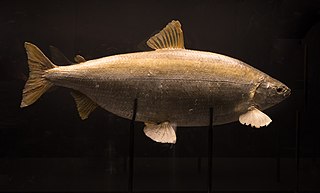
Coregonus fera, commonly called the true fera, is a presumed extinct freshwater fish from Lake Geneva in Switzerland and France.
Coregonus confusus is a freshwater whitefish from Switzerland. It is also known by its native Swiss German common name, spelled pfärrit, pfarrig, and pfärrig. It was described as Coregonus annectens confusus by Victor Fatio in 1885 from syntypes which have been lost in 1902. The species is rare and only known with certainty from Lake Biel. There is also a possibility that it might occur in Lake Neuchâtel. It vanished from Lake Murten in the 1960s due to eutrophication and water level management.

The humpback whitefish, also referred to as the bottom whitefish, the Arctic whitefish or the pidschian, is a species of freshwater whitefish with a northern distribution. It is one of the members in the broader common whitefish complex, or the Coregonus clupeaformis complex. This fish lives in estuaries and brackish water near river mouths, in deltas and in slowly running rivers, in large lakes with tributaries, and floodplain lakes. It can migrate long distances upriver for spawning.
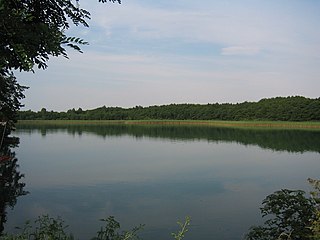
Breiter Luzin is a lake in Mecklenburg-Vorpommern, Germany. At an elevation of 84.3 m, its surface area is 3.45 km². It is home to an endemic dwarfed whitefish, Coregonus lucinensis.
Coregonus fontanae, also known as the Stechlin cisco, Fontane cisco, or Fontane's cisco, is a species of freshwater whitefish in the family Salmonidae endemic to the Großer Stechlinsee in northern Germany. It is believed to have recently evolved from the sympatric vendace, Coregonus albula.
Coregonus bavaricus, the Ammersee kilch, is a species of freshwater whitefish endemic to Lake Ammersee in the German state of Upper Bavaria. A small, silver-colored fish, it typically lives between 60–85 m (197–279 ft) deep, though shallower in the summer months. In the early 20th century the Ammersee kilch was an important commercial species, but its population declined drastically in the 1930s onward due to overfishing and eutrophication of the only lake in which it is found. Today it is listed as Critically Endangered by the International Union for Conservation of Nature (IUCN) and may be on the verge of extinction.
Coregonus bezola was a species of freshwater whitefish in the family Salmonidae. It was endemic to the Lac du Bourget in Savoie, France where it was pelagic in deep water. The maximum length recorded for this species is 32.0 centimetres (12.6 in). It is known from specimens collected in the late 19th century, and was reported by fishermen to have disappeared in the 1960s. It spawned in January and February, on the muddy bottom of the lake, at a depth of 70 to 80 metres (230–260 ft).

Coregonus maraena, referred to in English as the maraene, maraena whitefish or the whitefish, is a whitefish of the family Salmonidae that occurs in the Baltic Sea basin - in the sea itself and the inflowing rivers, and in several lakes as landlocked populations. It is found in Denmark, Estonia, Finland, Germany, Latvia, Lithuania, Netherlands, Norway, Poland, Slovakia, Russia and Sweden. As of 2013, it has been listed as a vulnerable species by the IUCN and as endangered by HELCOM. It is an extremely important fish within the Baltic Sea ecosystem, both for population equilibrium and for the local diets of the surrounding human population. Due to a variety of factors, mostly overfishing, the maraena’s population dwindled to near-extinction levels. Thus, rampant repopulation was enacted to preserve this important fish.
Coregonus widegreni, also called the Valaam whitefish, is a putative species of freshwater whitefish, a part of the common whitefish complex from Northern Europe. It is a demersal form of freshwater whitefish that feeds on benthic invertebrates. It spawns in late autumn, and can reach a length of 55 cm maximum. It is characterized by a low gill raker density.















